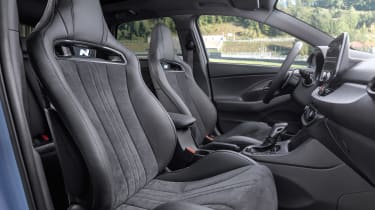Hyundai i30 N (2018 - 2024) – interior and tech
Cabin materials are a little shaky, but the fundamental touchpoints are bang on
Save for lots of hard and slightly scratchy textured plastics here and there, there’s not a lot to complain about in the i30 N’s cabin. As with the standard i30, it’s logically laid out, feels well built and offers good levels of comfort and refinement.
The big changes for the update include a new infotainment screen that’s both wider and has a higher resolution than before. The actual interface is more complicated than it used to be, but the core functionality is still there, and there are even more N-mode toys to play with.
There’s also the new lightweight sports seat option, which replaces the fundamentally good standard seats with a thinner and more aggressive-looking design. As well as having better lateral support and a more direct connection to the chassis, the new seats also look the part, and don’t lose out on their built-in heaters.
The steering wheel is good to hold – a chunky (but not too chunky) three-spoke affair whose buttons for stereo controls, cruise control and information display functions are logically arranged. Here you’ll also find two larger, Performance Blue buttons used to select drive modes. On the left spoke is the button to switch between Eco, Comfort and Sport modes, while the right, denoted with a small chequered flag, switches between ‘N’ mode and a custom setting.
Those custom settings are adjusted through the central touchscreen, and are one of the i30 N’s highlights, allowing you to tailor the drive to your own preferences, forever just a couple of quick presses on the N button away, and only ever a press on the left-hand button away from switching back to the car’s more relaxed modes. For us, it’s driving modes done just right.
A final mention deservedly goes to the dial pack which is the same as on the old car and mercifully lacks the overwrought graphics of the i20 and Kona N. Instead, you’re left with clear and crisp analogue dials with an active red line (à la BMW M) and a well-sized display between that shows only useful information. Post-facelift standard i30s have replaced this with a completely digital instrument cluster, so the active decision to keep on with this older dial pack is a welcome move from the team.




